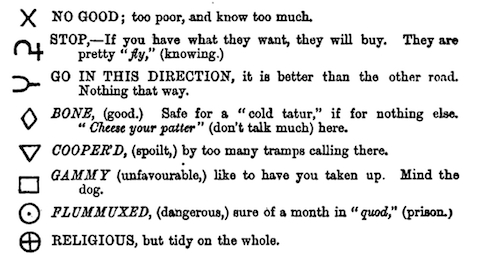 Last summer we marveled at the complexity of hobo pictographs, which we took to be a uniquely American phenomenon. But as this 1872 dictionary of slang from London makes clear, the tradition of wordless transient communication traces back to the Old World. In decidedly non-PC language, the author argues that this code was created by the semi-nomads we now call Travellers, who used markings to alert comrades to meeting spots. And as discussed in our earlier post, this mode of communication was attuned to the Western habit of processing information from left to right:
Last summer we marveled at the complexity of hobo pictographs, which we took to be a uniquely American phenomenon. But as this 1872 dictionary of slang from London makes clear, the tradition of wordless transient communication traces back to the Old World. In decidedly non-PC language, the author argues that this code was created by the semi-nomads we now call Travellers, who used markings to alert comrades to meeting spots. And as discussed in our earlier post, this mode of communication was attuned to the Western habit of processing information from left to right:
Gipsies (sic) follow their brethren by numerous marks, such as strewing handfuls of grass in the daytime at a four lane or a crossroads; the grass being strewn down the road the gang have taken; also, by a cross being made on the ground by a stick or a knife–the longest end of the cross denotes the route taken. In the nighttime a cleft stick is placed in the fence at the cross roads, with an arm pointing down the road their comrades have taken. The marks are always placed on the left-hand side, so that the stragglers can easily and readily find them.
The dictionary’s whole list of bygone slang is worth a read, too. So many great words to add to my everyday vocabulary, starting with “akeybo” and “albertopolis.”


Like gas stations in rural Texas after 10 pm, comments are closed.